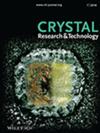重Si掺杂GaAsN的光致发光机理
IF 1.9
4区 材料科学
Q3 CRYSTALLOGRAPHY
引用次数: 2
摘要
讨论了重掺Si的GaAsN的光致发光机理,并提出了利用其光致发光峰能量评价电子有效质量的方法。随着温度的升高,PL峰值能量单调降低,因此与适度掺Si的GaAsN相比,重掺Si的GaAsN的S形特性消失。这一结果表明,与简并n型GaAs一样,这种重掺Si的GaAsN的主要PL过程是从费米能到价带顶部的光学跃迁,与温度无关。由于PL峰值能量由带隙能量、Burstein-Moss效应增加的能量和带隙缩小减少的能量之和表示,因此对于氮成分为0.6%的重掺Si的GaAsN,计算出me*为0.098 m0,其中m0为电子质量。这一结果与前人的研究结果吻合较好,说明估计me的方法对稀释GaAsN是有效的。本文章由计算机程序翻译,如有差异,请以英文原文为准。
Photoluminescence Mechanism in Heavily Si‐Doped GaAsN
The photoluminescence (PL) mechanism is discussed for heavily Si‐doped GaAsN, and the evaluation method of electron effective mass (me*) is proposed using its PL peak energy. PL peak energy monotonically decreases as increasing temperature, so the S‐shape characteristic is vanished for this heavily Si‐doped GaAsN as opposed to moderately Si‐doped GaAsN. This result shows that the dominant PL process is an optical transition from the Fermi energy to the top of valence band independent of temperature for this heavily Si‐doped GaAsN, as with degenerate n‐type GaAs. Because PL peak energy is expressed by the sum of bandgap energy, the increased energy of the Burstein–Moss effect, and the decreased energy of the bandgap narrowing, me* is calculated to be 0.098 m0 for this heavily Si‐doped GaAsN with nitrogen composition of 0.6%, where m0 is the electron mass. This result agrees well with previous studies, meaning that the method for estimation of me is effective for dilute GaAsN.
求助全文
通过发布文献求助,成功后即可免费获取论文全文。
去求助
来源期刊
自引率
6.70%
发文量
121
审稿时长
1.9 months
期刊介绍:
The journal Crystal Research and Technology is a pure online Journal (since 2012).
Crystal Research and Technology is an international journal examining all aspects of research within experimental, industrial, and theoretical crystallography. The journal covers the relevant aspects of
-crystal growth techniques and phenomena (including bulk growth, thin films)
-modern crystalline materials (e.g. smart materials, nanocrystals, quasicrystals, liquid crystals)
-industrial crystallisation
-application of crystals in materials science, electronics, data storage, and optics
-experimental, simulation and theoretical studies of the structural properties of crystals
-crystallographic computing

 求助内容:
求助内容: 应助结果提醒方式:
应助结果提醒方式:


